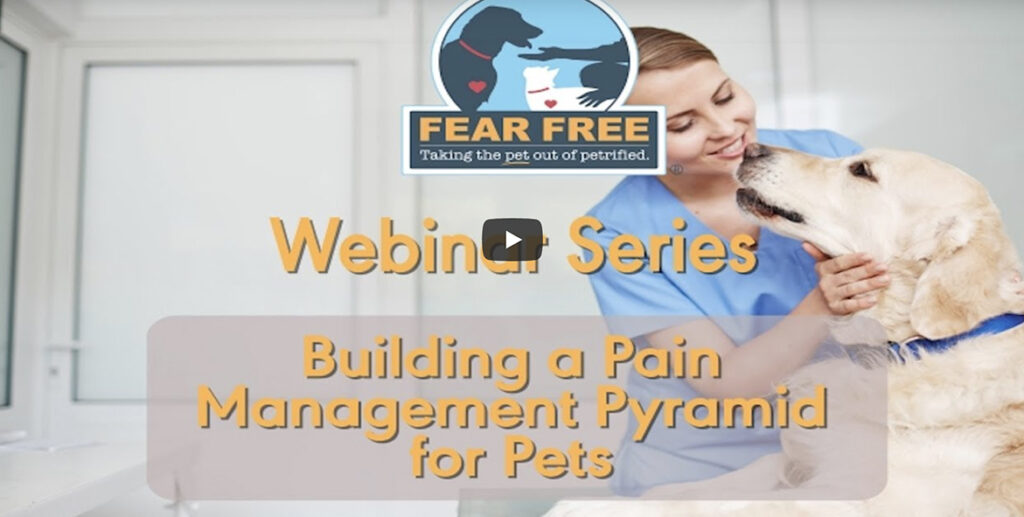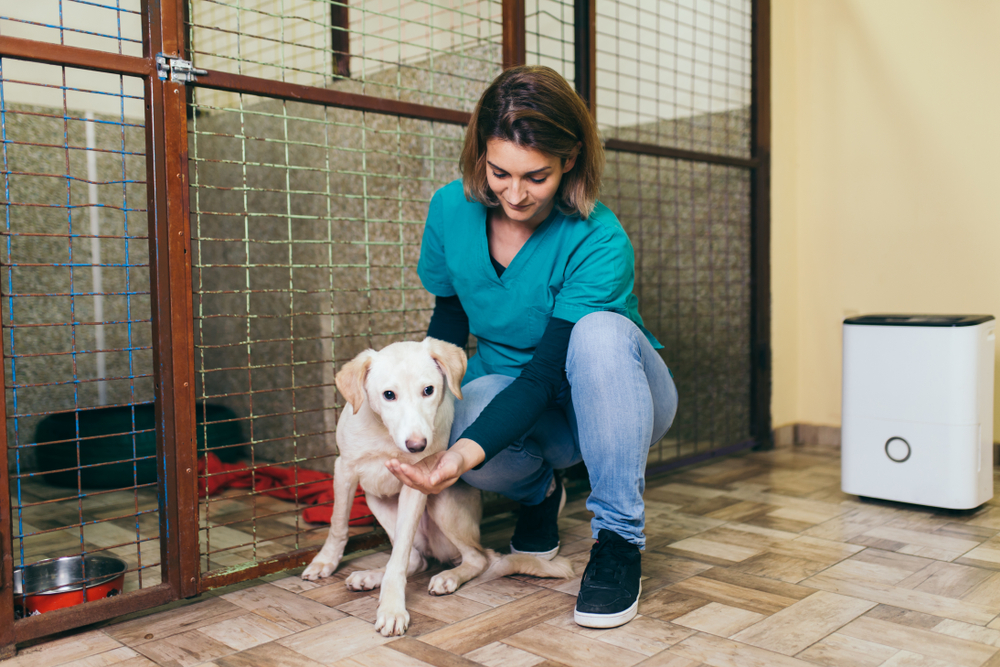
1. Parasites disrupt the pet owner-pet bond.
No pet owner wants to see the dreaded “rice” on their dog’s rear, or learn their dog has been shedding eggs from intestinal parasites and contaminating their yard. Intestinal parasites aren’t just stressful for pet owners, but for pets, too. An indoor dog could suddenly be relegated to the outdoors or confined to a single room – all while a frantic pet owner tries to reach their veterinarian after hours. Dogs are intelligent creatures, but that doesn’t mean they will understand why their owner is suddenly distant, worried or disgusted. The bottom line: Parasitic infections can undermine efforts to create a warm, inviting, Fear Free home for a pet.
2. Intestinal parasite prevalence rates are rising.
The average number of heartworm-positive dogs per clinic increased by 21.7 percent in a 2017 survey conducted by the American Heartworm Society.1 While pet owners may recognize the importance of protecting against heartworm, they might not realize the threats posed by intestinal parasites as well. Along with the increasing threat of heartworm, prevalence rates of intestinal parasites are also on the rise. In shelter dogs:
- Canine hookworm (Ancylostoma caninum) prevalence rates increased from 19.2 percent average prevalence nationwide in 1996 to 29.8 percent in 20142,3
- Canine whipworm (Trichuris vulpis) prevalence rates increased from 14.3 percent average prevalence nationwide in 1996 to 18.7 percent in 20142,3
3. Pets are out and about (and exposed) more than ever.
Dog parks are prime areas for the spread of parasites like hookworm, whipworm and roundworm. In a pilot study conducted across the Dallas-Fort Worth area, 80 percent of sampled dog parks had at least one dog test positive for intestinal parasites.4 If a client frequents dog parks or other areas with lots of dogs, they should know that it increases their dog’s risk of picking up a parasitic infection.
4. Shelter dogs may increase parasite prevalence in your area.
Did you know nearly two thirds of animal shelters and rescue organizations do not test, treat or provide heartworm prevention before transporting dogs? From 2014 to 2017 shelters imported 114,000 dogs to Colorado, and during that same time period Colorado saw a 67.5 percent increase in heartworm prevalence. Even if you practice in an area with historically low parasite prevalence, shelter dog relocation may contribute to a higher local risk of parasitic disease for your clients.5
5. Owners and their families are at risk, too.
Pet owners often don’t realize that zoonotic disease transmission is a real threat to their families, especially young children.6 If clients question the necessity of intestinal parasite protection, explain that roundworm eggs can remain in an environment for years6 — leaving pets and human family members at risk long after the problem was thought to be “over.” Even walking around barefoot in their own yard could be a risk, because infective hookworm larvae can penetrate human skin to spread zoonotic disease.7
Regardless of the many Fear Free reasons to protect against intestinal parasites, educating pet owners on the risks of these “hidden” parasites can be a challenge. Using the conversation starters above can help support a recommendation for heartworm prevention that also protects against hookworm, roundworm, whipworm, and tapeworm, as well as potentially increasing compliance. After all, a client who understands the value of intestinal parasite protection for their pet is that much more likely to administer it.
References
-
- American Heartworm Society. AHS survey finds increase in heartworm cases. Available at: https://d3ft8sckhnqim2.cloudfront.net/images/bulletin/AHS-1705-May-17-Summer-Bulletin.pdf?1535050388. Accessed June 20, 2019.
- Blagburn BL, Lindsay DS, Vaughan JL et al. Prevalence of canine parasites based on fecal flotation. Comp Cont Educ Pract. 1996;18(5):483-509.
- Blagburn BL, Butler JM, Mount J, et al. Prevalence of internal parasites in shelter dogs based on centrifugal fecal flotation [abstract]. In Proceedings AAVP 59th Annual Meeting. Denver; 2014. 26-29 July 2014.
- Elanco Animal Health. Data on file.
- Drake J, Parrish RS. Dog importation and changes in heartworm prevalence in Colorado 2013-2017. Parasite Vector. 2019;12:207.
- Companion Animal Parasite Council. Ascarid. Available at: https://www.capcvet.org/guidelines/ascarid/. Accessed May 16, 2018.
- Companion Animal Parasite Council. Trichuris vulpis. Available at: https://www.capcvet.org/guidelines/trichuris-vulpis/. Accessed May 16, 2018.
- This article was reviewed/edited by board-certified veterinary behaviorist Dr. Kenneth Martin and/or veterinary technician specialist in behavior Debbie Martin, LVT.
 This post is brought to you by our sponsor, Elanco, the makers of Credelio® (lotilaner) and
This post is brought to you by our sponsor, Elanco, the makers of Credelio® (lotilaner) and
Interceptor® Plus (milbemycin oxime/praziquantel).INDICATIONS FOR CREDELIOCredelio kills adult fleas, treats flea infestations (Ctenocephalides felis) and treats and controls tick infestations [Amblyomma americanum (lone star tick), Dermacentor variabilis (American dog tick), Ixodes scapularis (black-legged tick) and Rhipicephalus sanguineus (brown dog tick)] for one month in dogs and puppies 8 weeks or older and 4.4 pounds or more.
IMPORTANT SAFETY INFORMATION FOR CREDELIO
The safe use of Credelio in breeding, pregnant or lactating dogs has not been evaluated. Use with caution in dogs with a history of seizures. The most frequently reported adverse reactions are weight loss, elevated blood urea nitrogen, increased urination, and diarrhea. Please see full Credelio product information for complete safety information or contact your veterinarian.
INDICATIONS FOR INTERCEPTOR PLUS
Interceptor Plus prevents heartworm disease (D. immitis) and treats and controls adult hookworm (A. caninum), roundworm (T. canis, T. leonina), whipworm (T. vulpis) and tapeworm infections (T. pisiformis, E. multilocularis, E. granulosus and D. caninum) in dogs and puppies 6 weeks or older and 2 pounds or greater.
IMPORTANT SAFETY INFORMATION FOR INTERCEPTOR PLUS
Treatment with fewer than 6 monthly doses after the last exposure to mosquitoes may not provide complete heartworm prevention. Prior to administration of Interceptor Plus (milbemycin oxime/praziquantel), dogs should be tested for existing heartworm infections. The safety of Interceptor Plus has not been evaluated in dogs used for breeding or in lactating females. The following adverse reactions have been reported in dogs after administration of milbemycin oxime or praziquantel: vomiting, diarrhea, depression/lethargy, ataxia, anorexia, convulsions, weakness, and salivation. Please see full Interceptor Plus product information for complete safety information or contact your veterinarian
Credelio, Interceptor, Elanco and the diagonal bar logo are trademarks of Elanco or its affiliates.
© 2019 Elanco. PM-US-19-1483

 My cat Cleo is nearly 17 and receives sub-q fluids regularly at home. She used to grumble and try to get away but once I started Fear Free, I began giving her favorite crunchy treats before, during, and after administering fluids. Now she purrs through the whole procedure, and any time I approach the spot in the house where we do fluids, she walks up for “crunchie time.” I’ve been able to switch back to a larger needle because she doesn’t notice the poke while snacking, which makes administration faster, too.
My cat Cleo is nearly 17 and receives sub-q fluids regularly at home. She used to grumble and try to get away but once I started Fear Free, I began giving her favorite crunchy treats before, during, and after administering fluids. Now she purrs through the whole procedure, and any time I approach the spot in the house where we do fluids, she walks up for “crunchie time.” I’ve been able to switch back to a larger needle because she doesn’t notice the poke while snacking, which makes administration faster, too. Chewy had a lot of fear and anxiety at the veterinary clinic, causing her to behave aggressively and making it difficult to give her the care she needed. While training her, I observed various signs of pain, which were most likely adding to her anxiety. I alerted her caregiver to my observations so she could better assess and monitor her dog and update her veterinarian. Chewy and her caregiver had previously had negative and traumatic experiences at a veterinary clinic so I referred them to Keystone Veterinary Clinic, which has Fear Free Certified Professionals who created a handling plan to enable Chewy to have a thorough exam, radiographs, and other diagnostics in a safe and low-stress manner. I also worked with the owner to begin muzzle training. The combination of appropriate scheduling, handling, and sedation, Chewy was able to receive the diagnostics and treatment she needed.
Chewy had a lot of fear and anxiety at the veterinary clinic, causing her to behave aggressively and making it difficult to give her the care she needed. While training her, I observed various signs of pain, which were most likely adding to her anxiety. I alerted her caregiver to my observations so she could better assess and monitor her dog and update her veterinarian. Chewy and her caregiver had previously had negative and traumatic experiences at a veterinary clinic so I referred them to Keystone Veterinary Clinic, which has Fear Free Certified Professionals who created a handling plan to enable Chewy to have a thorough exam, radiographs, and other diagnostics in a safe and low-stress manner. I also worked with the owner to begin muzzle training. The combination of appropriate scheduling, handling, and sedation, Chewy was able to receive the diagnostics and treatment she needed. Gus had developed severe resource guarding of his food and water bowls, as well as fear and anxiety regarding being touched and having his gear put on and taken off. As a result, he snapped at and bit a walker. We worked closely with his owners and utilized Fear Free strategies and positive reinforcement training to get Gus comfortable with having strangers in the home. We were eventually able to find a solution that allowed Gus to be comfortable having walkers touch and refill his water bowl and approach his food bowl without any signs of resource guarding or fear, anxiety, and stress. Now Gus happily greets his walker at the door, demands affection, and has no issues on his walk or in his home.
Gus had developed severe resource guarding of his food and water bowls, as well as fear and anxiety regarding being touched and having his gear put on and taken off. As a result, he snapped at and bit a walker. We worked closely with his owners and utilized Fear Free strategies and positive reinforcement training to get Gus comfortable with having strangers in the home. We were eventually able to find a solution that allowed Gus to be comfortable having walkers touch and refill his water bowl and approach his food bowl without any signs of resource guarding or fear, anxiety, and stress. Now Gus happily greets his walker at the door, demands affection, and has no issues on his walk or in his home.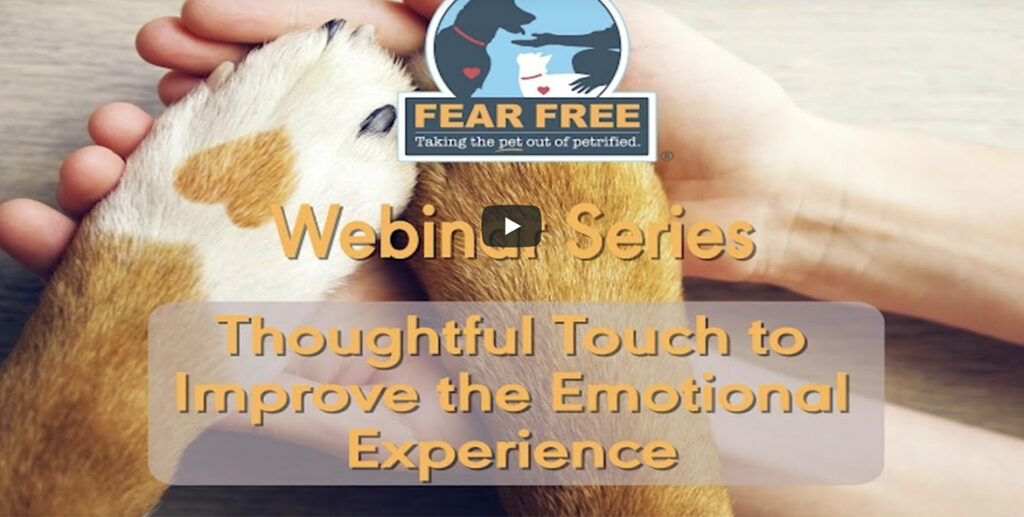
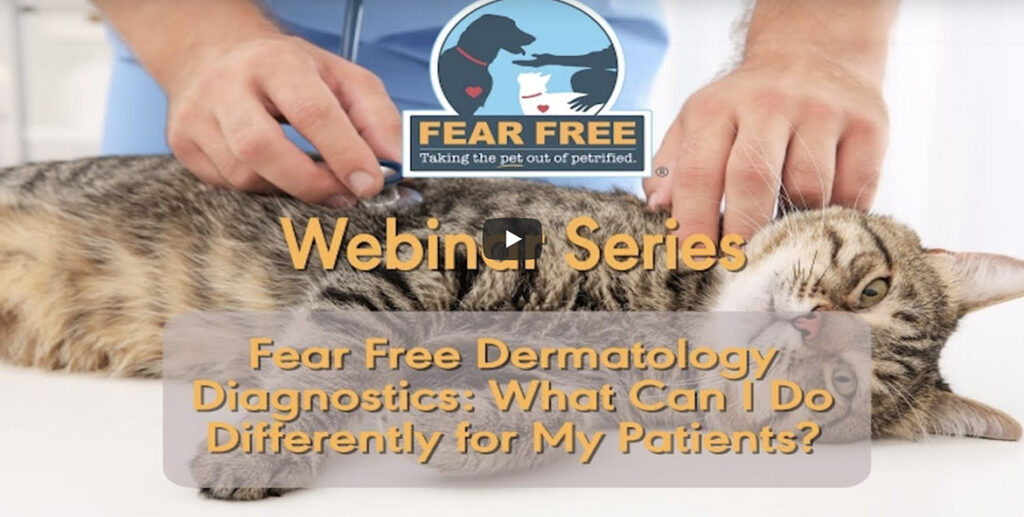
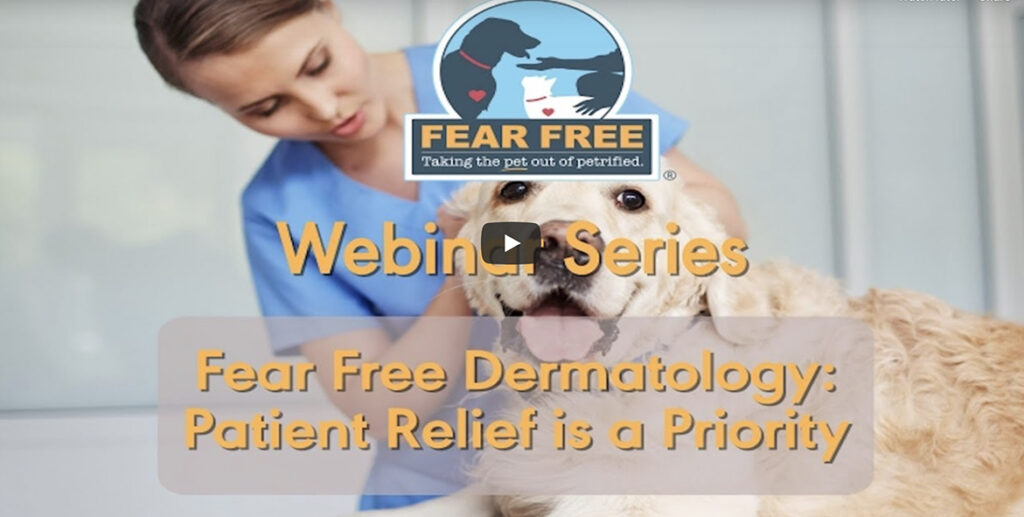

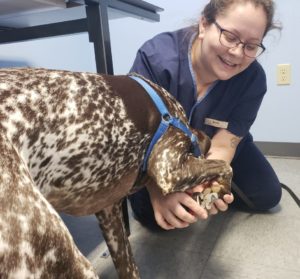 Eva, a spunky and energetic German Shorthaired Pointer, is a staff favorite for more than just her adorable, tongue-hanging-out smile, but there’s one thing Eva never liked: nail trims! Prior to the hospital’s transition to Fear Free in early 2017, it was a challenge to trim Eva’s nails, requiring three or four technicians to assist with restraint, plus a muzzle and calming cap. We started implementing Fear Free teachings right away with all of our patients, but one staff member has really gone above and beyond her commitment to Fear Free training to help Eva overcome her fear. Kayla McNeely volunteered to assist with Eva’s nail trims, and she can now perform Eva’s nail trims solo, standing, with minimal assistance from Eva’s mom, Sheila, who says, “Kayla’s patience and kindness have worked wonders with my girl.” Our hospital requires all staff members to go through Fear Free training to help ensure that all of our clients, patients, and staff have a pleasant experience during their exams. We have seen a tremendous difference in many patients at our hospital since our transition to Fear Free, but Kayla and Eva’s journey together is by far our most successful Fear Free adventure to date.
Eva, a spunky and energetic German Shorthaired Pointer, is a staff favorite for more than just her adorable, tongue-hanging-out smile, but there’s one thing Eva never liked: nail trims! Prior to the hospital’s transition to Fear Free in early 2017, it was a challenge to trim Eva’s nails, requiring three or four technicians to assist with restraint, plus a muzzle and calming cap. We started implementing Fear Free teachings right away with all of our patients, but one staff member has really gone above and beyond her commitment to Fear Free training to help Eva overcome her fear. Kayla McNeely volunteered to assist with Eva’s nail trims, and she can now perform Eva’s nail trims solo, standing, with minimal assistance from Eva’s mom, Sheila, who says, “Kayla’s patience and kindness have worked wonders with my girl.” Our hospital requires all staff members to go through Fear Free training to help ensure that all of our clients, patients, and staff have a pleasant experience during their exams. We have seen a tremendous difference in many patients at our hospital since our transition to Fear Free, but Kayla and Eva’s journey together is by far our most successful Fear Free adventure to date.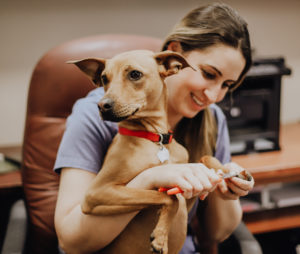 One-year-old Ruba disliked having her feet touched and her nails trimmed. We trialed trazodone for six months for all nail trim visits. It started to work well, and we discovered she preferred sitting in Dr. DaCosta’s lap. Ruba now comes in for frequent nail trims with minimal restraint and no trazodone needed. We are so proud of her progress and the team’s dedication to using Fear Free techniques.
One-year-old Ruba disliked having her feet touched and her nails trimmed. We trialed trazodone for six months for all nail trim visits. It started to work well, and we discovered she preferred sitting in Dr. DaCosta’s lap. Ruba now comes in for frequent nail trims with minimal restraint and no trazodone needed. We are so proud of her progress and the team’s dedication to using Fear Free techniques. Mikey Bear used to require sedation before blood draws, but I showed his amazing humans how to hold his back leg for a blood draw and wet the vein while giving him treats to get him used to the feeling. They worked on this for a month, and when they came back, the blood draw was a snap. I discovered they had added another step to the homework and were poking the vein with a toothpick at home.
Mikey Bear used to require sedation before blood draws, but I showed his amazing humans how to hold his back leg for a blood draw and wet the vein while giving him treats to get him used to the feeling. They worked on this for a month, and when they came back, the blood draw was a snap. I discovered they had added another step to the homework and were poking the vein with a toothpick at home.
 When I worked at a veterinary emergency clinic, one of the dogs in the hospital was so fearful that he would begin to thrash and hit his head in the ground if anyone touched his leash. I sat in front of his cage with my back to him so he could become accustomed to my scent. Then I started placing treats in his cage and turning my back again. Eventually, I opened the door and put a leash on him and sat next to the door. When he came out of the cage on his own, I was able to walk him with no tension on the leash. Gaining an animal’s trust is a beautiful thing.
When I worked at a veterinary emergency clinic, one of the dogs in the hospital was so fearful that he would begin to thrash and hit his head in the ground if anyone touched his leash. I sat in front of his cage with my back to him so he could become accustomed to my scent. Then I started placing treats in his cage and turning my back again. Eventually, I opened the door and put a leash on him and sat next to the door. When he came out of the cage on his own, I was able to walk him with no tension on the leash. Gaining an animal’s trust is a beautiful thing.